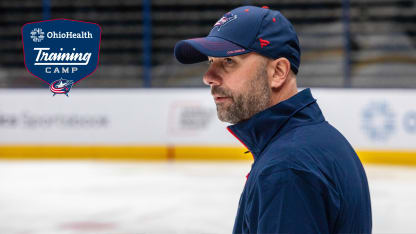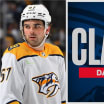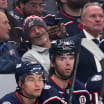Over the past few years, it’s become a BlueJackets.com fixture – what have we learned about the Blue Jackets in the opening days of training camp, presented by OhioHealth.
So far, we are one week into on-ice work, with three preseason games and four other full days of practice in the books. A lot can and will change before the Oct. 12 opener vs. Philadelphia at Nationwide Arena, but things are starting to take shape in some ways.
Patrik Laine has created chemistry with rookie (and air fryer buddy) Adam Fantilli, but he’s also getting a look at center. New head coach Pascal Vincent and his staff have plans to improve the power play and the team defensive structure, while players are competing for spots in the lineup.
Here’s a look at the major storylines so far and what they might mean come opening night, starting with big No. 29.
Laine might just be a center
When camp started, the Blue Jackets had Laine and Fantilli together, with the rookie in the middle and Laine on his customary spot on the wing.
But the last two days, with the Jackets splitting up the NHL players into a game group Tuesday night in St. Louis and a non-game group, Laine has been taking rushes and practicing in the center position.
It’s something he tried for a (largely successful) two-game cameo last spring before an injury ended his season. And when we spoke to Laine this summer, it was clear he wanted to give it another go.
"I'm still open to it," Laine said. "There's still things that need to be worked on, obviously. It's a very responsible position overall. It's a lot of responsibilities, but if it ends up happening, I'm excited. If it doesn't, it doesn't, but at least I've done my homework on that and will try to be fully prepared for that. But if it doesn't happen, I'll just play somewhere else."
So, while it’s clear the Finnish forward at least wants to give it a try, coaches have to do what’s best for the team. But if you’re a coach, well, it’s not hard to think about what someone with Laine’s size, speed and skill could bring to the middle of the ice.
“The vision I have is when he skates the puck and he’s building speed through the neutral zone, he’s hard to stop,” Vincent said Wednesday. “That’s what we are trying to see, if it’s gonna work. He knows and we know that that’s something we want to try. If it works, great. We all benefit. He’s a 6-5 right-shot forward. If it works, it changes the picture of our group up front. But if it doesn’t work, it was a good try and we’ll move forward. So to me, it’s intriguing to see him in that position.”
As Vincent said, it’s a “win-win” for the organization and the player. If Laine takes to the spot, the Blue Jackets suddenly have a very interesting player who can make things happen in the middle of the ice. If he doesn’t, he’s gained valuable perspective on what it’s like to play another position, and he can just slide back to wing.
Here’s where some might argue that playing center is a very different animal defensively, though analytics would say Laine turned in a pretty solid performance as a two-way player a season ago. Vincent even spoke last season about how Laine actually would play too deep as a winger at times last year, so committed he was to his defensive responsibilities.
This time around, Vincent – who has known Laine since the player entered the league and was acting head coach last season when the in-game experiment took place – acknowledges there are new reads to learn for a player at center than wing, but he expects Laine can handle that.
“Patrik is a guy that was brought up in Finland, and the focus on the defensive game is quite intense,” Vincent said. “His reads are pretty good defensively. Of course there’s new reads and some things he’ll have to adjust if we continue in that trend, but I’m not too concerned about his defensive reads.”
Another benefit? Laine is committed to giving it his all, and Vincent sees the utility of trying to make a change that the player fully believes in. It’s all part of the two-way street that exists between player and coach.
“I told him, he has to do the right things,” Vincent said. “His conditioning must be way up there, his skating in practice and pushing himself. And so far, I’d like to say that he’s been doing all of this. So we’re going to practice it and see how it goes in practices, and if we like it, then we’re going to continue the project.”
But if it doesn’t work...
There’s also a scenario that has to be pretty enticing to Vincent, and that’s Laine forming a dynamic duo with Fantilli as his centerman.
We wrote earlier this week about the bond the two started to forge this summer, when Laine took Fantilli under his wing and invited him to stay at his home this summer in Columbus. On the ice, that has already paid some dividends, as the two looked to be quite threatening together in Saturday’s open practice and Sunday’s exhibition game against Pittsburgh.
It’s a small sample size, but the two – along with winger Alexandre Texier – look like they could be very fun to watch together.
“Obviously he’s really easy to play with,” Fantilli said of Laine. “He’s super skilled. He’s super smart. He works really hard, so it’s been really easy to be on a line with him. Obviously the brain he has, I’m trying to catch up and be in the right areas, and I think everything has been going really smoothly. And Texier on the other side has been amazing, being in the right spot and making quick little six- or seven-foot passes that are getting us going. They’ve both been great.”
It’s not hard to imagine why the trio might be successful, as all have aspects of a 200-foot game in their repertoires, and the skill shared between the three is pretty obvious. All are big bodies who can skate, and all are equally adept at setting up teammates or finishing plays.
For his part, Laine is excited about what the No. 3 overall pick brings to the table.
“He’s a big boy,” Laine said of Fantilli. “He can skate well. He has a really good shot, really good hands. I feel like he’s doing everything well. And I told him, you don’t need to do any magic tricks when you get here. You just need to work hard and show up. Everybody’s going to respect you. I know you’ll have a chance to play with some really good players. You just have to work hard every day and everything is going to happen.”
A team effort on the power play
If there’s one place Blue Jackets fans want to see better out of the team, it’s on the power play, and that’s a very fair point.
A season ago, Columbus finished 26th in the NHL in power-play percentage, checking in at 18.3 percent. The year before that, the Blue Jackets were 24th; in the shortened 2021 season, 27th; in 2019-20, 27th as well
OK, you get the idea.
The past two seasons, the power play was run by Vincent, and there was a stretch in the middle of the campaign when most of the pieces were healthy and the Blue Jackets were clicking pretty good. In a 20-game run from mid-February through the end of March, for example, the team had one of the best marks in the NHL at 29.1 percent.
At the end of the day, a strong power play can be a key piece of a winning team, something Vincent is acutely aware of. So as head coach, his philosophy is to focus on special teams, and his plan is simple. His assistants – new hire Mark Recchi with the power play, defensive leader Steve McCarthy on the penalty kill – will run the show and be the face of the units to the players, but it will be a team effort behind the scenes.
“I give the power play guy total control, the penalty kill guy total control, to present it, to prepare, to pre-scout, to teach, but we’re going to do everything as a team,” Vincent said. “I call it the red team. So if we’re talking about the power play, the two guys on the red team are there to challenge you on everything. Like, ‘OK, that’s the penalty kill. We’re the power play, this is how we’re going to beat your penalty kill. And this is how we’re going to stop your power play.’
“So we’re going to be challenging all the time. It’s going to be done by the whole group. We are all going to work on it.”
He said those words before the hiring of Recchi, a 22-year NHL veteran who posted 200 power-play goals (19th all-time) in his 1,600-plus contests before being inducted into the Hockey Hall of Fame. Recchi brings a ton of experience to the table, and he outlined his power-play philosophy a bit after being hired.
“They have to be connected,” he said. “The one thing you can have is a couple of different looks, especially when you have a one-timer like Patrik. Teams will set up against him. It’s finding ways to do it so it doesn’t get stagnant and they aren’t able to just focus on Patrik. When you have a weapon like that, it’s a great thing, but now you have to mobilize that and use different things. … We’re going to have to be a little bit creative. Quick puck movement is really important.”
Of course, it all sounds good, but the proof will be in the numbers when all is said and done. Recchi ran the power play in his last job with the New Jersey, and he drew ire from fans when the Devils finished 28th in the NHL on the man advantage. It’s also worth pointing out those Devils weren’t quite last year’s Devils, who made a historic 49-point jump in the standings a year ago.
With the Blue Jackets, pieces include a pair of quality quarterbacks in Zach Werenski and Adam Boqvist; Laine’s tremendous one-timer; one of the game’s most consistent offensive producers in Johnny Gaudreau; a notable netfront presence in Boone Jenner; and young talents like Kirill Marchenko and Kent Johnson. The ingredients are there, and Recchi is ready to get cooking.
“We have lots of great pieces, and it’s exciting for me to be able to try to help them and work with them,” he said.
A defensive focus as well
Not to keep harping on what went wrong a season ago, but Vincent knows the Blue Jackets have to be better defensively.
You can come up with any reason you want – and the injuries to such key pieces as Werenski were certainly huge, as the Blue Jackets routinely had games where three of the six defensemen dressed had each played less than 100 career games – but improvement is needed. Columbus gave up a franchise-worst 4.01 goals per game, and were it not for Anaheim checking in at 4.09 allowed, the Blue Jackets would have been the worst defensive team in the league in the last decade.
So, what’s the plan? Vincent laid out three places the Blue Jackets can get better.
- First is personnel, where the Blue Jackets will welcome back Werenski, a two-time All-Star, with open arms and acquired dependable veterans Ivan Provorov and Damon Severson.
- Secondly, tracking – the art of the routes players take on the backcheck – will be a focus. Vincent said the analytics presented to him show that the No. 1 factor in a team being successful when it comes to wins and losses is how well it performs in this area.
- Third, the team will change its defensive zone structure slightly, work that is under way in the early days of camp.
“We are going to focus on those areas to start,” Vincent said. “I want this to become our DNA.”
By trade, Vincent is an offensive coach, but that gives him a perspective on what makes a team hard to break down defensively. He also believes strongly that offense is defense, as you can’t give up chances if you possess the puck and keep it in the offensive zone.
We could go on and on, as Vincent discussed a few different scheme tweaks and preached that the Blue Jackets are going to work on structure and being connected all over the ice, but you get the idea.
Veteran center Sean Kuraly said the team discussed the analytics quickly in a team meeting early in camp, but the numbers he cares about most are wins and losses. As long as what is being taught is consistent and communicated clearly, he’s on board.
“I think as a player, you want objectives, and we’ve been given three clear ones up front of things that equate to playoff teams,” Kuraly said. “Pazzy doesn’t tell us how he got the numbers and go through all the graphs and stuff. He says these are the numbers and it’s a quick little mention, but you get my attention when you say, ‘How do you make the playoffs?’ Perfect. Let’s do it.”
A lot of competition
Kuraly had an interesting answer when he was asked about the return of Texier to the team after the French forward spent last year playing in Europe.
Kuraly is excited to have Texier back because he knows what he brings to the table, but he also noted that it’s another body that adds competition to the CBJ lineup.
“Anytime you’re looking over your shoulder and knowing, ‘There’s a guy right behind me, I better keep it moving,’ I think it’s healthy for our group,” Kuraly said.
Vincent wasn’t in the room when the Central Ohio native said that, but the coach likely would have smiled.
“I remember Paul Maurice saying when we were in Winnipeg, we want to get to a point where there’s a little bit of fear in the dressing room as far as, ‘I might lose my job here. There’s guys coming and pushing,’” Vincent said. “That’s what we want. We want to create that healthy competition where if you don’t do your job and you get to a point where some people behind you are pushing, they might steal your job, that’s when teams win.”
And it’s fair to say there’s plenty of competition on hand. Because of the injuries and turnover a season ago, the Blue Jackets skated a franchise-record 47 players, and 37 of them are in camp. All of them trained all summer with eyes on being on the 23-man opening night roster, and all of them likely believe they deserve to be there.
But you can do the math, and all of them won’t be there. It’s healthy competition, especially at the bottom of the lineup, where the Blue Jackets will have to sort out exactly what they are looking for to start the season.
It takes more than 23 players to get through an NHL season, so everyone will likely be a part of it at some point, but there is something to be said for surviving the final cuts in October. That’s why it had to be satisfying for players like Carson Meyer and Emil Bemstrom, who have each posted two-goal performances in the first three games of the preseason.
That alone won’t allow a player to make the roster, but it might be a tiebreaker in the end.
“Every time we go on the ice, we evaluate the players,” Vincent said Wednesday. “We talk about it after every game. It could be a good track, it could be a blocked shot, it could be a good breakout. It could be anything, but when a guy performs like Bemmer did yesterday, you have checkmarks next to his name because he’s doing the right things. Yes, we do evaluate everything, and that part, if on top of it he’s producing, of course it makes a difference.”




















